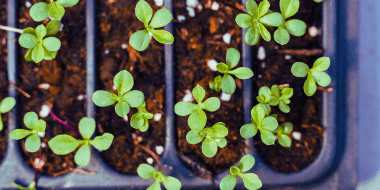Do you dream of pulling carrots from the garden with your toddler or laughing with your 8-year-old as you bite into an amazing, home grown tomatoes…but you have no idea how to begin? This brief intro to gardening will help get you started this spring with a little less fear and trepidation.
On top of the obvious benefits of having fresh healthy food at your fingertips and knowing exactly under what conditions your food has been grown, it can bring you closer to nature, to your family and to your community. Gardening can also literally make you happier being in direct contact with certain organisms in the soil!
One of the beautiful things about growing your own food is that you know exactly what has been done to it (or NOT done!). Growing without sprays and synthetic fertilizers isn’t hard, it just takes a mental shift to thinking about your garden as a holistic system rather than a collection of plants, and not expecting things to always look like they do in the grocery store.
Most important components of an organic garden
Healthy soil = strong healthy plants
Yes, it’s all about that base! Focus first on what’s going on below ground rather than what’s happening above ground. The key to organic gardening is healthy soil. If the soil is healthy and full of life the plants will be healthy and strong and able to fend off most diseases and pests. Weak plants actually attract pests! Add compost on a yearly basis and use a straw or leaf mulch to protect the soil, add structure, retain moisture and release nutrients over time.
Crop rotation and companion planting
To reduce the risk of diseases, move your plants around the garden from year to year so that any fungi and diseases in the soil can't readily find a host in the spring. Companion planting is the art of placing plants that boost each other's production near each other and keeping antagonists apart.
Attract beneficial predators and parasites
Let nature take care of those pesky bugs for you. Everything is part of a food chain, so you just need to attract the right predators into your garden and they will keep the 'bad' guys in check. Include plants such as dill, fennel, or yarrow that will attract beneficial insects like lacewings and ladybugs, shrubs for birds to hang out in, and piles of brush or rocks for snakes, birds and ladybugs.
Observation and monitoring
A few ‘bad’ bugs are normal and easy to control by picking them off and disposing of them. Don’t let numbers get out of control. If this happens you can wait a couple of days and hope that predators will come flocking in to the smorgasbord or you may have to resort to organic sprays (or just accept the crop loss).
Start small
Start with a few plants that you and your kids love. Easy crops to start with are lettuce, peas, beans, potatoes, carrots, and beets. None of them need that much care and do not have too many pests to worry about. Lettuce, other greens and peas will give you quick results to keep the kids engaged while the root crops will cultivate a little more patience (ha ha). Tomatoes are a fairly easy and productive plant to start with too but need a little more consistency in watering than the others listed here or your nicely ripening tomatoes will start to turn mushy and brown underneath with something called ‘bottom rot'. Cherry tomatoes make great kids’ snacks and are more forgiving of moisture variability than larger tomatoes.
Options for your garden design
Where are you going to grow? How much sun does it get? How accessible is it? You can go the typical rototill route and carve out a rectangle from your yard, but I recommend sheet mulching, sometimes called lasagne gardening, or raised garden beds.
Raised garden beds
- It doesn't matter whether the soil underneath them is contaminated (or even non-existent)
- They will heat up earlier in the spring so you can get planting as soon as possible
- You don't have to bend down as far so it's easier on your body
- They look neat and tidy
Sheet mulch or lasagne gardening
This is a method of adding layers of organic material that will sink down and compost over a surprisingly short time and result in a very rich, healthy environment for your plants. It will get rid of the grass while improving the soil and supporting all the life in there working for you.
With the sheet mulch method you can easily shape your garden any way you like. The straight row method that most gardeners use to lay out their plants is actually the least efficient use of land. Look up keyhole and mandala gardening for some ideas on alternative garden layout that makes better use of space and is also more aesthetically pleasing. For more on how to create and maintain a keyhole garden, the Gardening Mentor has detailed information.
Planting your own garden can be a deeply satisfying and healthful pursuit, even for the smallest ones (gardens and people, that is!). You choose what you put into it; you choose what you get out of it. A small, initial effort can result in a relaxing, not-too-time-consuming hobby, a full-blown personal obsession or even something that can change the world!
Further reading
Gaia's Garden by Toby Hemenway
Grow Great Grub by Gayla Trail
I'll Never Marry a Farmer by Lois Hole









